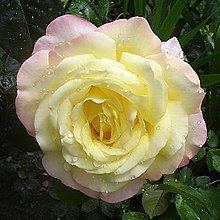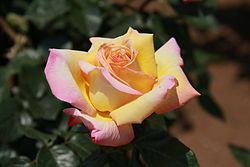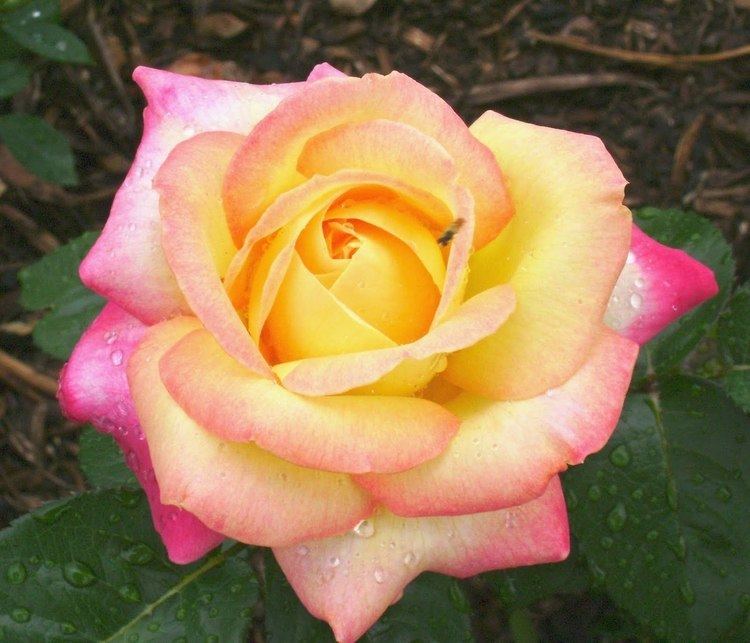 | ||
Hybrid parentage Unnamed seedling × 'Margaret McGredy' Marketing names Gioia, Gloria Dei, Peace Awards All-America Rose Selections Similar Rose, Hybrid tea rose, Rosa 'Eden', Rosa 'Double Delight', Rosa 'Mister Lincoln' | ||
The Peace rose, correctly Rosa 'Madame A. Meilland', is a well-known and successful garden rose. By 1992, over one hundred million plants of this hybrid tea had been sold. The Cultivar has large flowers of a light yellow to cream color, slightly flushed at the petal edges with crimson-pink. It is hardy and vigorous and relatively resistant to disease, making it popular in gardens as well as in the floral trade.
Contents

It was developed by French horticulturist Francis Meilland in the years 1935 to 1939. When Meilland foresaw the German invasion of France, he sent cuttings to friends in Italy, Turkey, Germany, and the United States to protect the new rose. It is said that it was sent to the US on the last plane available before the German invasion where it was safely propagated by the Conard Pyle Co. during the war.

Development

The cultivar was hybridized in 1935, receiving the number 3-35-40 (the third hybridization in 1935, and the 40th cultivar selected for test proliferation). As those first tests produced beautiful flowers in autumn of 1936, the first no. 3-35-40 were grown in Meilland's rose fields in June 1939. That summer, cuttings were sent to partners in other countries. According to Meilland's records, 'Madame A. Meilland' was hybridized from the hybrid tea 'Margaret McGredy' and an unnamed seedling.
Naming

Because Meilland had sent out his cuttings just before the war, communication between the cultivators was not possible, which is why the rose received different names. In France, Francis and Alain Meilland decided to call the cultivar 'Madame A. Meilland', in honor of the Francis' deceased mother, Alain Meilland's wife Claudia. This is the formal cultivar name. Other names are considered by the International Code of Nomenclature for Cultivated Plants as trade or selling names. In Italy it was called Gioia (It. for "joy"), in Germany Gloria Dei (lat. for "glory of God") and in the USA, Sweden and Norway Peace.
The rose became known as Peace in the following way. In early 1945 rose grower Meilland wrote to Field Marshal Alan Brooke (later Viscount Alanbrooke), the principal author of the master strategy that won the Second World War, to thank him for his key part in the liberation of France and to ask if Brooke would give his name to the rose. Brooke declined saying that, though he was honored to be asked, his name would soon be forgotten and a much better and more enduring name would be "Peace".
The adoption of the trade name "Peace" was publicly announced in the United States on 29 April 1945 by the introducers, Messrs Conard Pyle Co. This was the very day that Berlin fell, a day considered a turning point in the Second World War in Europe. Later that year Peace roses were given to each of the delegations at the inaugural meeting of the United Nations in San Francisco, each with a note which read:
"We hope the 'Peace' rose will influence men’s thoughts for everlasting world peace".Peter Beales, English rose grower and expert, said in his book Roses:
"'Peace', without doubt, is the finest Hybrid Tea ever raised and it will remain a standard variety forever".Description
'Mme A. Meilland' forms elegant buds that open to large, cupped flowers with a high-centered form and an average diameter of 15 cm (6 in). Their color is a combination of pale yellow and crimson edges that depends on the location, the weather and changes as the flower fades. The durable flowers are very full, with 40 to 43 petals, survive rainy periods, and have a sweet and fruity fragrance that varies in its strength from mild to strong. The cultivar flowers continuously throughout the season up to the first frost.
The vigorous shrub grows 120 to 200 cm (4 ft to 6 1⁄2 ft) high and 90 to 125 cm (3 ft to 4 ft 1 in) wide, is winter hardy down to −23 °C (−9 °F, USDA zone 6), half-shade tolerant, and disease resistant. The large, glossy leaves are very dark and leathery. 'Mme A. Meilland' is very versatile—it is used as cut rose and as garden rose, solitarily or in groups, as standard rose to 90 cm (3 ft) high, or in containers.
Awards
'Mme A. Meilland' has been granted numerous awards, starting with the selection as Most Beautiful French Rose in Lyon in 1942, gold medals in Lyon (1942), Portland (1944), The Hague (1965) and from the Royal National Rose Society in 1947. In 1944, it was included into the All-America Rose Selection.
In 1976, it was the first cultivar to be granted the highest award a rose can be granted when it was selected as World's Favorite Rose and included into the Rose Hall of Fame.
Sports and hybrid offspring
As an often cultivated plant, several sports of 'Mme A. Meilland' are known. 'Climbing Peace' (Kordes 1951) has slightly bigger flowers but flowers less well, 'Chicago Peace' (Johnston 1962) differs mainly in its richer colors with a mixture of crimson and apricot, while 'Kronenbourg' (syn. 'Flaming Peace', McGredy 1966) has red petals with yellow backs, creating an interesting contrast.
It is also used in the hybridization of new cultivars, and played a role in the development of well known cultivars such as 'Garden Party' (Swim, 1959), 'Super Star' (Tantau, 1960), and 'Pullman Orient Express' (Lim & Twomey, 1991).
